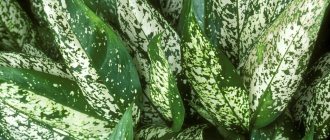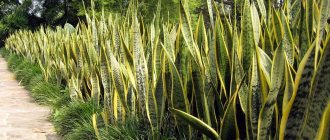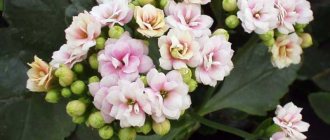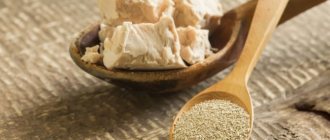- January 2, 2019
- Houseplants
- Suzanna Nyrova
Sansevieria, “pike tail”, is a plant that can withstand almost anything: dry and polluted air, high temperatures and sun, frequent changes in location, lack of water (even a month without watering can cope). The only thing he doesn't like is the soil being too wet. Sansevieria is an interesting decorative variety of indoor flowers with long beautiful leaves. Let's look at how to care for a pike tail flower at home.
Origin
Sansevieria is a genus that includes about 70 species of herbaceous shrubby succulents. This is a plant that originates from the tropical regions of Africa - it can be found around the equator and in the southern part of the continent. It grows in the hot and humid forests of Asia. Grows well in dry and rocky soil and in full sun. The flower was discovered in the mid-18th century by an Italian aristocrat from Naples, Raimondo de Sangro, Prince of San Severo, and the plant's name comes from the name of the place. Its other names, depending on the place of growth, are: “pike tail” flower, “Indian sword”, “wolf tail”, “mother-in-law’s tongue”. This plant is also called “devil’s tongue”, “leopard lily”, “snake skin”, “African hemp”.
If Sansevieria does not grow
The simplest reason why the mother-in-law's tongue stopped developing is the excessive crampedness of the potty. If a young plant has stopped growing, you should pay attention to the care conditions:
- improper watering;
- bright sunlight or shading;
- low temperatures;
- draft.
All these factors not only slow down development, but also become causes of Sansevieria disease. The plant itself will signal the problem.
Pike tongue has soft leaves
First, the plates begin to turn yellow, then soften at the base. The situation is caused by waterlogging of the soil. The only way to really save the situation is by transplanting it into a new pot. To do this, perform the following steps:
- the flower is carefully removed from the container;
- the roots are freed from the ground and inspected;
Note! If the root system has rotted, there is no point in resuscitating the entire plant.
- soft yellow leaves are removed.
Fresh soil is poured into a new container and the sprout is planted in it. The pot is placed away from the sun's rays and the watering regime is monitored.
Why do Sansevieria have limp leaves?
The opposite situation, when the soil is too dry, leads to lethargy of the plant (especially if the room temperature is below +15°). A quick way to bring Sansevieria to life is to move the pot to a warm place, remove the flaccid plates and water the soil.
Mother-in-law's drooping tongue
If signs of trunk rot are noticed, it is better to cut off the undamaged parts of the leaves and root them in a new container. Throw away the remains of the diseased plant.
Other developmental problems
Sansevieria, like cactus, does not like frequent watering. Excess moisture, as well as violation of other regimes, lead to serious deviations in the development of the pike tail.
How to fix sansevieria problems
| Sign | Cause | Recipe for resuscitation |
| Twisting | Leaves may curl due to lack of moisture | It is enough to establish regular, but not frequent watering, and the plant will stop curling |
| Rugosity | Affected by prolonged exposure to shade and lack of moisture. | The light regime is corrected by gradually moving the pot towards the window. After this, watering is adjusted |
| The leaves have fallen | Evidence that the plant is cold | It is enough to move the flower to a warm room, and the foliage will quickly straighten |
Knowing what sign indicates a problem, it is easier to understand why Sansevieria leaves curl (wither, turn yellow, etc.). This will allow you to provide first aid to the plant in time and establish proper care.
Types, names and photos of the “pike tail” flower
Sansevieria are divided into two large groups:
- tall - their height reaches up to 2 meters, they are distinguished by lanceolate leaves;
- low-growing - small plants with straight or curved leaves, growing from a rosette.
The most beautiful and famous varieties are:
- Laurenti is a beautiful plant with gray-green, striped, sword-shaped leaves with a bright rim. The rosette consists of six or more striped leaves. The height of the plant can even exceed one meter.
- Hanni – characterized by shorter stature. It has green, wide, shiny leaves with irregular dark patterns. Reaches a height of 20 cm.
- Golden Honey is a low plant with wide lanceolate leaves with characteristic yellow oblong spots along the edge. Reaches a height of 15 cm.
- Silver Honey is a low plant with a silvery sheen on the leaves, distinguished by dark edging and the presence of transverse stripes.
- Hanni Cristata - with green, wide shiny leaves. Up to 20 cm in height. The second name is African hemp. It can often be seen in medical institutions and offices, as it perfectly purifies the air and eliminates odors.
- Golden Flame is a beautiful indoor flower with yellowish-green leaves. Quite simple and easy to care for.
- Black Gold is a variety with dark green leaves and a yellow edge.
Properties of Sansevieria
Sansevieria contains a large number of biologically active substances, but the most important of them are saponins, because if used correctly, they can be very useful. In official medicine, saponins are used in the production of products that have anti-inflammatory, expectorant, choleretic and laxative properties. In alternative medicine, this plant is used for inflammation of the oral cavity, cystitis, otitis, cuts and other damage to the skin. Saponins also have foaming properties, so they are widely used in the cosmetics industry for the production of shampoos and liquid soap.
During pregnancy, it is better to avoid using sansevieria as a healing agent, since it contains substances that have an abortifacient effect.
Sansevieria cylindrical. Planting and care.
Appearance
The piketail flower is a succulent that can store water in its leaves. It has a creeping rhizome from which fleshy, thick leaves grow. The latter are up to 7 cm wide and usually 40–80 cm high (some reach a length of 1.5 m). The leaves of dwarf varieties are about 15–30 cm long.
“Pike Tail” is a flower with hard, raised, sharp leaves of a dark green color. They are decorated with transverse, irregular stripes and patterns (brighter or darker than the color of the leaves). Some varieties have a cream or yellow-white edge. The leaves grow directly from the soil (from the rhizome), with 2–3 new increments appearing every year. If the plant is properly cultivated, it should bloom in late spring or early summer. It produces a long (30–90 cm) thin rod, at the end of which a branched inflorescence grows. The small, delicate, fragrant flowers are yellow-green or green-white. After flowering, the inflorescence should be removed to prevent fruit formation.
What's interesting about Akalifa
The plant is native to the tropical rainforests of Southeast Asia, Australia and the Pacific Islands. In the natural environment, representatives of the genus include evergreen shrubs, herbaceous perennials and small trees.
During the flowering phase, some varieties of Akalifa are covered with long, bright red inflorescences hanging down. Due to the appearance of the flower, the plant received the common name “fox tail” or “foxtail”. The word “akalitha” itself comes from the Greek language and is translated as “nettle”.
The color of the leaves varies from green to brown with spots.
Benefit
The “pike tail” flower, in addition to its decorative qualities, has a number of beneficial health properties:
- purifies the air and eliminates odors;
- plant extract is used in medicine as an anti-inflammatory, choleretic and laxative;
- cut leaves of the plant, like aloe, are used to heal wounds;
- a decoction of the flower is used for infections of the genitourinary system;
- The juice of the plant helps with otitis media.
It is interesting that no matter how much research scientists have conducted, they have not been able to find a single property of a flower that is harmful to humans or animals. On the contrary, the plant is so useful that it is often found not only in apartments, but also in schools, hospitals and other public places.
Why does it bloom?
According to folklore, the flowering of Sansevieria is considered a rare occurrence, which makes this event special.
The flowering of pike tail at any time of the year except winter promises serious changes. They can be both positive and negative.
- The most favorable sign is the flowering of a houseplant in the summer season. This event does not have a negative impact on household members.
- The appearance of inflorescences on a pike’s tail is also considered the approval and blessing of the higher powers of all the undertakings and ideas of the household. Signs indicate that such a sign is a signal for action, new achievements and their favorable implementation.
- Sansevieria blooming in winter is considered a bad omen - this is an unkind sign, promising future serious quarrels in the family or major troubles at work.
- If during flowering the plant begins to wither, and the buds dry out and do not have time to open, this indicates that the family has a serious envious person.
Potting substrate
The indoor pike tail flower should be planted in a rough environment, it can even be rocky. Experts most often recommend cactus substrate, although equally good results in growing the plant are observed in a mixture of universal potting soil (pH 7.5), compost, sand or perlite. The use of peat should be minimal. The drainage layer should be placed on the bottom of the pot, which will ensure free drainage of excess water.
The following soil mixture can be used for the plant:
- turf – 2 parts;
- leaf soil – 1 part;
- humus – 1 part;
- peat – 1 part;
- sandy soil - 1 part.
Mix all components and place on a drainage layer.
Popular varieties
The pike tail plant has this Latin name - sansevieria trifasciata. The genus Sansevieria belongs to the Agave family. Pike tail is a frequent inhabitant of various houses and apartments. It is distinguished by unpretentiousness and endurance. He is not afraid of drafts, irregular watering, or drought. The flower can grow even in partial shade. He doesn't need frequent transplants.
It is valued by flower growers for its decorative properties. Variegated long leaves decorate any interior. It can be used to create compositions with other varieties. It has no stem, only leaf rosettes.
In the wild, the plant can be found in Indonesia, India, Africa, and Madagascar. The flower has many other names: Indian sword, cuckoo's tail, leopard lily.
Sansevieria is an ornamental foliage plant, but it can produce a flower stalk. The inflorescences are not particularly decorative, and they appear extremely rarely only if stressful conditions are created for the flower. But this does not mean that for flowering it is not necessary to follow the rules for keeping pike tail. The difference between the inflorescences is a pleasant aroma with notes of vanilla. The flowers are very small, have a whitish-greenish tint, open only in the evening, and a drop of nectar appears on them. Flowering lasts a long time.
Piketail or Sansivieria cylindrica
There are 2 main varieties of pike tail. The first group includes those plants that have lanceolate-shaped leaves. They are erect. They can even reach 150 cm in height. The second group includes those flowers whose foliage creates rosettes as they grow. These varieties are characterized by low growth. Both groups are characterized by high foliage density. The leaves themselves begin to form from the root.
For information
At the moment, more than 60 varieties of Sansevieria are known. They differ in appearance:
- Sansevieria Laurenti . Also called Lawrence variety. The leaves are long and narrow, their height reaches 150 cm. They have yellow stripes that border all the leaves.
- Hanni . Another famous variety that is very popular. The Sansevieria variety Hanni is distinguished by the presence of lush leaf rosettes. They can reach a height of no more than 20 cm. Each leaf has a decoration in the form of a light stripe, which is located transversely.
- Sansevieria Francis . This variety has foliage with a rough surface. The leaves are arranged in 5 rows. The stem is very tall at first, and then it begins to creep. The height of the leaves is no more than 15 cm.
- Sansevieria prolific . The rosettes can be from 30 to 60 cm in height. They have a rich dark green hue at the base. The shape is cylindrical, the upper part is sharp.
- Sansevieria big . The height of the rosette can reach 60 cm. The leaves are ovoid in shape. They are approximately 15 cm in width. The color is light green, but there are dark stripes that run transversely and turn into a reddish border.
These are just the most popular, but there are many other types.
Sansivieria Laurenti
Pike tail has many useful properties. The flower is used against various diseases of bacterial and viral nature. For example, it is used for inflammatory processes in the ovaries and cystitis. The plant can accelerate the process of tissue regeneration in wounds and ulcers. For otitis, use heated fresh juice to instill in the ears. In addition, the flower cleanses the air of harmful components. It is capable of absorbing radicals emitted by computers, televisions and other equipment.
Watering
The home flower “pike tail” is very drought resistant. The plant can withstand up to four weeks without watering. Excessive watering is much more dangerous for it, as a result of which the rhizome and leaves begin to rot (the plant cannot be saved in this case). Sansevieria should be “watered” in the summer once a week or once every two weeks; in winter, watering is limited in accordance with the principle: the colder it is, the less water. Sometimes it is enough to water it every three to four weeks (only when the soil in the pot is visibly dry).
For watering, you can use regular tap water, because Sansevieria loves calcium, and an excess of this element does not harm it. Water for irrigation should be at room temperature. It is best to pour water into the pot stand, and remove excess water, which will prevent rotting of the rhizomes and leaves.
Sansevieria does not tolerate spraying with water. Dust from the leaves should be regularly wiped with a damp cloth, which will improve the appearance of the plant and ensure more efficient photosynthesis. Products used to make houseplants glossy can cause brown or rusty spots to appear on the leaves.
Caring for Sansevieria at home
Lighting
Sansevieria will not die in low light conditions, but you should not constantly keep it in the back of the room. For a plant to be beautiful, with developed and bright leaves, it needs a lot of light, including sunlight. Only if the plant is placed on a south-facing window will it require shading on hot summer days.
For variegated varieties, the lighting requirements are somewhat different. If the proportion of yellow in the color is large enough, the plant needs less light; its excess can turn variegated leaves into ordinary green ones. But in low light conditions the plant will develop poorly, so for such varieties you need to choose an intermediate position relative to the window. Be sure to protect them from direct sun, as the colored areas of the leaves are more susceptible to sunburn.
Temperature
The plant is not very picky about temperature; Sansevieria feels most comfortable at 16-20 degrees at night, and 21-28 degrees during the day, but can withstand higher temperatures. If you are in cool conditions for a long time (for example, in winter in the passages of office buildings), you need to significantly reduce watering.
Watering
Sansevieria is a drought-resistant plant, succulent. Water it lightly; the next watering should be done when the soil dries out. The plant can withstand relatively long periods without water.
When watering, you need to make sure that water does not get inside the outlet, which could rot.
When the room temperature is low, Sansevieria needs to be watered less frequently; less frequent watering is also required if the plant is placed in the shade.
Sansevieria does not need spraying, but periodically you need to clean the leaves from dust using a cloth or a special broom.
Transfer
Sansevieria is replanted as the plant grows. Young plants can be replanted annually, adults - once every few years, when the pot becomes crowded. The new pot is shallow, 1.5-2 cm wider than the old one, sansevieria does not like a large volume of soil, and its root system is superficial and shallow.
Sansevieria needs light, low-nutrient soil that dries quickly. It is better to use specialized soil mixtures for cacti and succulents or make your own soil from leaf, turf soil and sand in equal parts. If the soil is prepared independently, it is advisable to calcinate it in the oven or steam it.
Top dressing
From May to September, sansevieria is fed once every 2 weeks. The rest of the time, you can apply fertilizer once a month, but during cool wintering you should not feed the plant at all. For feeding, use fertilizers for cacti and succulents or universal mineral fertilizer. For variegated varieties, do not use fertilizers with a high nitrogen content, which stimulates the production of chlorophyll and, as a result, greening of the leaves.
Transfer
Young sansevieria should be replanted every two years, older ones every three years. The new flower pot should have a diameter several centimeters larger than the old one. A layer of drainage 2-3 cm thick is laid on the bottom of the pot (this can be gravel or broken remains of a clay pot). The container must be heavy and durable. A relatively wide clay pot is ideal, because in light and narrow plastic containers a plant with heavy and tall leaves can easily fall, especially in winter when the soil in them is very dry. The pots should also have fairly thick walls, because the roots of the flower grow quickly and intensively, and a fragile container can simply crack under their pressure.
Use in landscape design
Antarctic meadow, tortuous meadow, and other species and varieties will fit perfectly into the garden in a variety of flower ensembles with various ornamental plants that have leaves and inflorescences of a different shape. Turf pike goes well with heather, iris, buzulnik, daylilies, and astilbes.
Thanks to the lush, abundant, numerous pike grass, it looks good along fences, walls, paths, alone and in groups on the lawn, in stone gardens, among trees, along ponds.
In addition to its simplicity, decorative appearance, abundant green mass, and numerous panicles, the turf pike forms hummocks. This is the reason for the change in the structure of the surface of the land, which acquires an uneven, bumpy surface. This feature must be taken into account when improving the garden area.
Reproduction
The plant can be propagated by cuttings or by dividing the rhizomes. Seedlings are selected in the spring (March - early April); two-year-old leaves are best suited for this. Cut off the leaf at the base and cut it into small pieces (approximately 5-6 cm). The lower part of the seedlings should be immersed in Kornevin for a while and then placed in a container filled with a mixture of sand and peat (1:1 ratio). For one and a half months, the seedlings should be placed in a bright room at a temperature of about +20 ° C, and then transplanted into separate pots.
Newly grown flowers do not replicate the characteristics of the mother plant - no matter what variety was used for propagation, the leaves of the new plant will always be dark green.
If you want to propagate a flower by dividing its rhizome, it is better to do this at the end of summer (September). The plant is carefully removed from the pot and divided into 2-3 parts. Each part should be treated with a fungicide to prevent dangerous diseases. It is necessary to wait a few days for the wounds on the plants to heal, and then transplant them into separate containers. Propagating Sansevieria by dividing the rhizomes ensures that the new plants will be exactly the same as the mother plant.
Brief description of cultivation
- Bloom . Grown as an ornamental foliage plant.
- Illumination . Grows well in a slightly shaded place or in bright but diffused light.
- Temperature regime . The flower grows well at normal room temperature, but in winter the room should not be colder than 16 degrees.
- Watering . Moisten the substrate systematically and moderately. In the cold season, watering should be less frequent than in summer.
- Air humidity . It grows normally at the level of air humidity that is typical for living rooms.
- Fertilizer . The flower is fed only during active growth once every 30 days; for this purpose, fertilizer is used for decorative foliage plants or for cacti.
- Rest period . Not clearly expressed.
- Transplant . The plant is replanted only if necessary, when its root system becomes cramped in the pot.
- Reproduction . Leaf cuttings and rhizome division.
- Harmful insects . Mealybugs, thrips and spider mites.
- Diseases . Root rot and anthracnose.
The most unpretentious flower! Sansevieria care, reproduction
Problems in growing
The plant is most often affected by the following pests:
- Spider mite - negatively affects the leaves, after which they become pale and begin to dry out. In this case, indoor flowers should be sprayed with an insecticide, and their leaves should be wiped more often with a damp cloth.
- Thrips - create entire colonies on the leaves of the plant, especially on their reverse side. The affected parts are characterized by a gray-brown color. The flower should be treated with insecticide and other chemicals against pests.
- Mealyworms - appear closer to the base of the plant and feed on the sap of the leaves. The affected part bends unnaturally, turns yellow and dies. Powdery mildew can be removed from the flower manually, then wipe all parts of the plant with a damp cloth and spray with karbofos.
In addition to pests, the plant can be attacked by diseases due to improper care.
- If the flower is overfertilized, young leaves become sluggish, weak and soft - then you should stop feeding for some time.
- If the plant is watered too much, brown spots and rot may appear on the leaves. The amount of water used to water the plant should be reduced, and affected leaves should be cut off right next to the rhizome and discarded.
- The leaves of plants that stand on the windowsill may be subject to burns due to strong sunlight (especially in summer). If signs of burn appear on the flower, cut out the damaged parts at the base and move the pot to partial shade.
- Too little lighting causes weaker coloring of the leaves and the disappearance of the decorative stripes and patterns of the plant.
If you like the pike tail flower, caring for it at home will not take much of your time. But Sansevieria will be an excellent decoration for your home.
Is it possible to keep the plant at home?
Despite a number of negative superstitions, it is useful to keep a pike tail in the house .
- This plant is able to filter negative emotions and protect household members from envious people and ill-wishers.
- By the appearance and condition of the flower, you can determine the quality of family relationships, and recognize signals for impending troubles in time.
- Thanks to a number of features, pike tail is a healing plant that can disinfect and heal wounds. A plant with healing properties cannot cause serious harm to its owner.
It is better for energetic and business people, public figures and those who feel vulnerable to keep a pike tail in the house.
With care and proper placement, the plant can have a positive impact on family members. Pike tail is a family plant that has a positive effect on young or established couples, as a result of which unmarried girls should be especially careful when handling the plant.
REFERENCE : For young girls just waiting for cohabitation or marriage, Sansevieria can help in choosing a partner. To do this, you need to guess the name of your chosen one on one leaf of the plant and wait 30 days. If nothing happens to the leaf, then in reality a strong connection can arise with this man. Otherwise, the union is doomed to failure.
Rules of care
Caring for a flowering plant is no different from caring for an ordinary one. Good soil drainage and infrequent watering are needed, which should be only after the soil in the pot is almost completely dry. It is best to avoid direct sunlight while providing enough light. The temperature should be maintained between 15°C and 20°C. Feeding - once every half month or month. The care and propagation of sansevieria is described in detail in a separate material.
The flowers of piketail (mother-in-law's tongue, sansevieria), although small, are quite pretty. If you didn’t manage to achieve flowering this year, don’t worry, but if you did, you can enjoy the fruits of your labor, which can become a simple decoration for any home.











